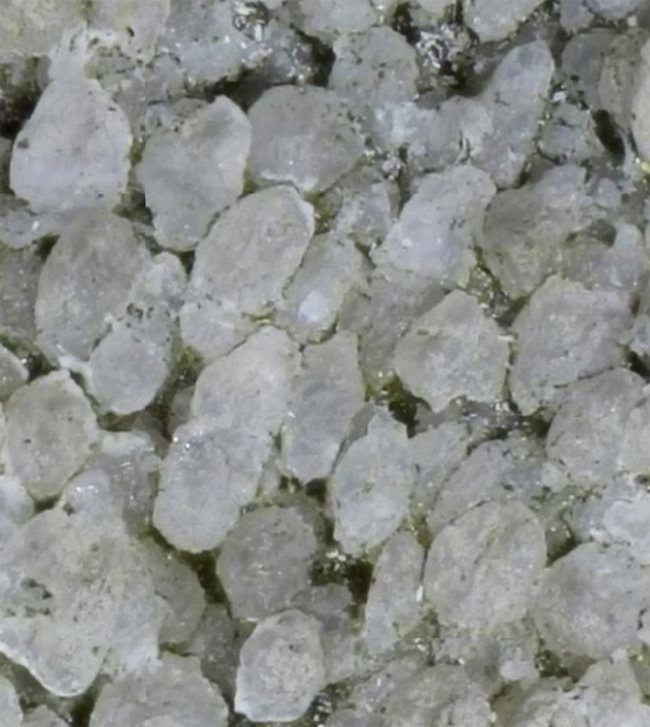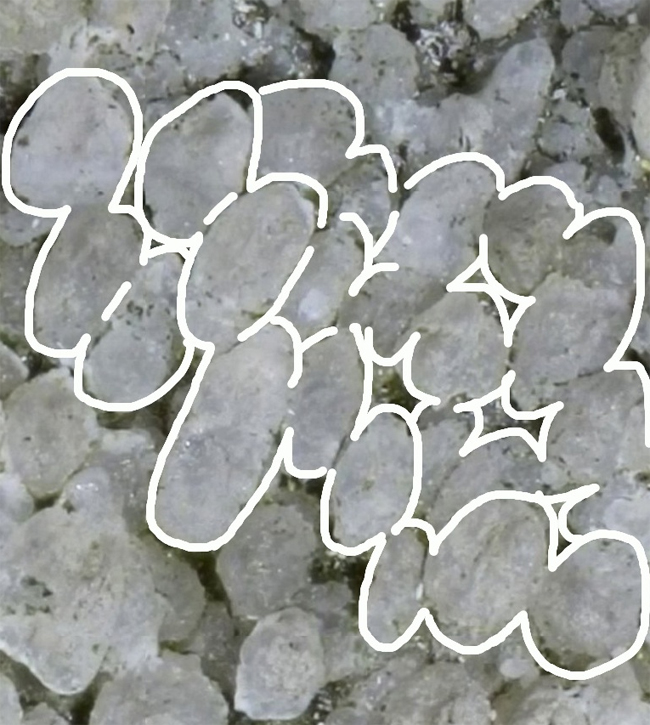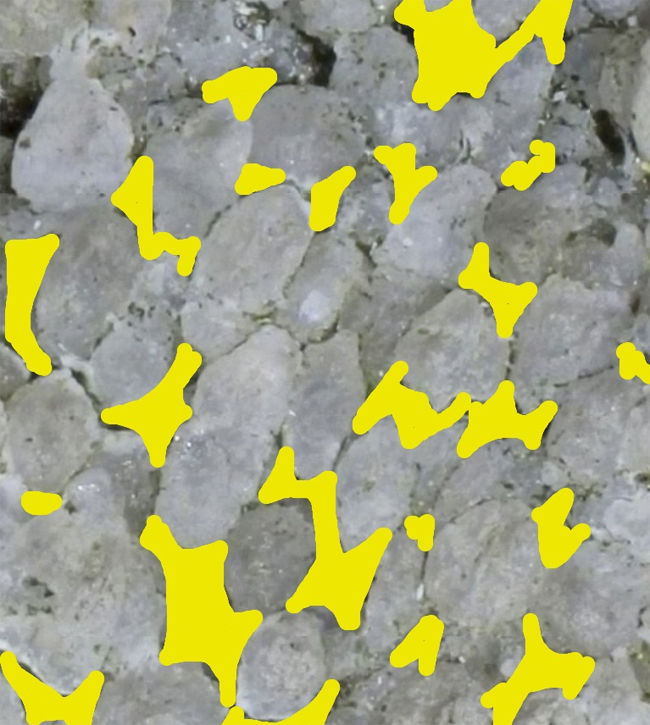17 April 2012
Strained Antietam Formation sandstone
Posted by Callan Bentley
I collected this sample the weekend before last on the Blue Ridge Thrust Fault field trip led by Alan Pitts. It’s a chunk of the Antietam Formation quartz sandstone, a Cambrian beach deposit. The face we photographed measures 15 cm by 12 cm.
It definitely looks best in full screen mode, so please feel encouraged to click through and explore it a bit. You’ll notice some great subtleties once you zoom in. To illustrated these, here is a screenshot I took with my iPad*, followed by (crudely) annotated versions, made with the “Whiteboard” app:

Long axes and short axes of the strain ellipse drawn in:

Outlining the edges of fused masses of sand grains:

Highlighting the empty space along strike of the long axes of the grains:

These images show that this sample experienced some degree of pressure solution (“p sol,” as I’ve learned to call it), and was squeezed (relative to this photo) from the upper left towards the lower right. This caused the rock to shorten in that direction, and the grains to pack closer together (even “suturing” into their neighbors) from the upper left towards the lower right. In contrast, the upper-right-to-lower-left direction is exemplified by both the long axes of the grains, and empty space in the “pressure shadow” of resistant grains. In some places in the main GigaPan, you can even see some white fringes in the X-axis direction that may be pressure fringes of new mineral deposits.
Pretty sweet little sample. The weathering with individual grains standing out in high relief (minimal cement) was what originally caught my eye, but then the preferred alignment was what made me decide to keep it, and ask Robin to subject it to the M.A.G.I.C. macro photography treatment last week. Not only is the sample itself cool, but I think Robin did an amazing job with the image. This is one of my favorite macro GigaPans that our group has produced so far.
_______________________________
* GigaPans are Flash-based, so they don’t work on regular web browsers in the iPad. There is an app for viewing them on the iPad, but it had some problems, and is currently being re-engineered. I’m assured that people are working on it. In the meantime, the “work-around” way to view GigaPans on the iPad is with the following URL (for this specific GigaPan):
http://gigapan.com/mobile/iOS/1.0/?id=103122
For other GigaPans, just copy the unique I.D. number of the image and replace the final part of the URL (after the “equals” sign) with that number. Hours of fun geologic exploration await!


 Callan Bentley is Associate Professor of Geology at Piedmont Virginia Community College in Charlottesville, Virginia. He is a Fellow of the Geological Society of America. For his work on this blog, the National Association of Geoscience Teachers recognized him with the James Shea Award. He has also won the Outstanding Faculty Award from the State Council on Higher Education in Virginia, and the Biggs Award for Excellence in Geoscience Teaching from the Geoscience Education Division of the Geological Society of America. In previous years, Callan served as a contributing editor at EARTH magazine, President of the Geological Society of Washington and President the Geo2YC division of NAGT.
Callan Bentley is Associate Professor of Geology at Piedmont Virginia Community College in Charlottesville, Virginia. He is a Fellow of the Geological Society of America. For his work on this blog, the National Association of Geoscience Teachers recognized him with the James Shea Award. He has also won the Outstanding Faculty Award from the State Council on Higher Education in Virginia, and the Biggs Award for Excellence in Geoscience Teaching from the Geoscience Education Division of the Geological Society of America. In previous years, Callan served as a contributing editor at EARTH magazine, President of the Geological Society of Washington and President the Geo2YC division of NAGT.
that’s pretty cool
As a petroleum geologist who looks at sandstone every day, my first reaction to the screenshot was “WOW!” That’s gotta be nearly 30% porosity, which is close to the maximum for sandstone reservoirs and would be any oil finder’s dream. (We tend to notice the holes first and the grains second.)
I quickly realized–confirmed by your text–that it’s a weathered surface and the porosity is probably secondary (i.e. the cement has been weathered out). Any idea what the primary cement was? I’d guess it was a carbonate, though I see some snow-white stuff near the center of the gigapan that might be kaolinite or another authigenic clay. Nice as the specimen is, I’d like to take a hammer to it and see what’s inside!